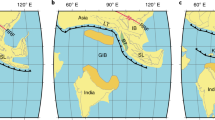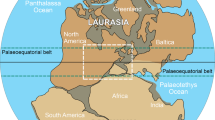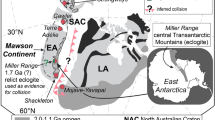Abstract
A consensus has emerged that during the Palaeozoic several landmasses progressively collided to form the supercontinent Pangaea, which subsequently split up in the Mesozoic and Tertiary to produce the present array of continents. But whereas there is a high measure of agreement about the general shape of the early Jurassic Pangaea, shortly before the initial Atlantic opening, three very different reconstructions of the end-Palaeozoic supercontinent have recently been proposed. These differences, which involve the relative positions of the northern and southern sectors of Pangaea, known respectively as Laurasia and Gondwana, relate to the interpretation of palaeomagnetic data. The three constructions are here tested with reference to geological and palaeobiogeographic data and arguments.
This is a preview of subscription content, access via your institution
Access options
Subscribe to this journal
Receive 51 print issues and online access
$199.00 per year
only $3.90 per issue
Buy this article
- Purchase on Springer Link
- Instant access to full article PDF
Prices may be subject to local taxes which are calculated during checkout
Similar content being viewed by others
References
Vine, F. J. Spec. Pap. Palaeont. 12, 61–77 (1973).
van der Voo, R. & French, R. B. Earth Sci. Rev. 10, 99–119 (1974).
Scotese, C. R., Bambach, R. K., Barton, C., van der Voo, R. & Ziegler, A. M. J. Geol. 87, 217–277 (1979).
Morel, P. & Irving, E. J. geophys. Res. 86, 1853–1872 (1981).
Kanasewich, E. R., Havskov, I. & Evans, M. E. Can. J. Earth Sci. 15, 919–955 (1978).
Smith, A. G., Hurley, A. M. and Briden, J. C. Phanerozoic Palaeocontinental World Maps (Cambridge University Press, 1980).
Smith, A. G., Briden, J. C. & Drewry, G. E. Spec. Pap. Palaeont. 12, 1–42 (1973).
Murray, G. E. Geology of the Atlantic and Gulf Coastal Province of North America (Harper & Row, New York, 1961).
Dengo, G. in The Ocean Basins and Margins Vol. 3 (eds Nairn, A. E. M. & Stehli, F. G.) 283–327 (Plenum, New York, 1975).
Shagam, R. in The Ocean Basins and Margins Vol. 3 (eds Nairn, A. E. M. & Stehli, F. G.) 325–420 (Plenum, New York, 1975).
de Cserna, Z. in The Encyclopedia of World Regional Geology Part I (ed. Fairbridge, R. W.) 348–360 (Dowden, Hutchinson & Ross, Stroundsburg, 1975).
Trümpy, D. Bull. geol. Soc. Am. 54, 1281–1304 (1943).
Rios, J. M. in The Ocean Basins and Margins Vol. 4B (eds Nairn, A. E. M., Kanes, W. H. & Stehli, F. G.) 1–65 (Plenum, New York, 1978).
Dillon, W. P. & Sougy, J. M. A. in The Ocean Basins and Margins Vol. 2 (eds Nairn, A. E. M. & Stehli, F. G.) 315–390 (Plenum, New York, 1974).
Klemme, H. D. Bull. Am. Ass. petrol. Geol. 42, 477–512 (1958).
Hallam, A. J. Geol. 79, 129–157 (1971).
Badham, J. P. N. J. geol. Soc. 139, 495–504 (1982).
Sougy, G. Bull. Soc. geol. Fr. 11, 133–149 (1969).
Schenk, P. E. in North Atlantic Borderlands (eds Kerr, J. W. & Ferguson, L.) 119 (Canadian Society of Petroleum Geologists, 1981).
Rona, P. E. Bull. Am. Ass. petrol. Geol. 54, 129–157 (1970).
King, P. B. in The Ocean Basins and Margins Vol. 3 (eds Nairn, A. E. M. & Stehli, F. G.) 201–241 (Plenum, New York, 1975).
Bird, J. M. & Dewey, J. F. Bull. geol. Soc. Am. 81, 1031–1060 (1970).
Gobbett, D. J. in Atlas of Palaeobiogeography (ed. Hallam, A.) 151–158 (Elsevier, Amsterdam, 1973).
Hallam, A. Palaeogeogr. Palaeoclimatol, Palaeoecol. 35, 1–44 (1981).
Westermann, G. E. G. in The Ammonoidea (eds House, M. R. & Senior, J. R.) 459–498 (Academic, London, 1980).
Johnson, J. G. & Boucot, A. J. in Atlas of Palaeobiogeography (ed. Hallam, A.) 89–96 (Elsevier, Amsterdam, 1973).
Chaloner, W. G. & Lacey, W. S. Spec. Pap. Palaeont. 12, 271–289 (1973).
Ballance, P. F. & Reading, H. G. (eds) Spec. Publ. int. Ass. Sedimentol. 5 (1980).
Arthaud, F. & Matte, P. Bull. geol. Soc. Am. 88, 1305–1320 (1977).
Dewey, J. F. J. geol. Soc. 139, 371–412 (1982).
Ziegler, P. A. Geological Atlas of Western and Central Europe (Shell, London, 1982).
Ziegler, A. M. et al. in Paleobotany, Paleoecology and Evolution (ed. Niklas, K. J.) 231–266 (Praeger, New York, 1981).
Author information
Authors and Affiliations
Rights and permissions
About this article
Cite this article
Hallam, A. Supposed Permo-Triassic megashear between Laurasia and Gondwana. Nature 301, 499–502 (1983). https://doi.org/10.1038/301499a0
Received:
Accepted:
Issue Date:
DOI: https://doi.org/10.1038/301499a0
This article is cited by
-
The Paleozoic Central Patagonian Igneous Metamorphic Belt: its geodynamic and tectonic interpretation based on paleogeographic reconstructions
International Journal of Earth Sciences (2023)
-
Late Palaeozoic to early Mesozoic evolution of Pangaea
Nature (1986)
-
Metallogenetic evolution of the East Alpine Paleozoic basement
Geologische Rundschau (1984)
-
Reconstruction of eastern Gondwanaland
Nature (1983)
Comments
By submitting a comment you agree to abide by our Terms and Community Guidelines. If you find something abusive or that does not comply with our terms or guidelines please flag it as inappropriate.



